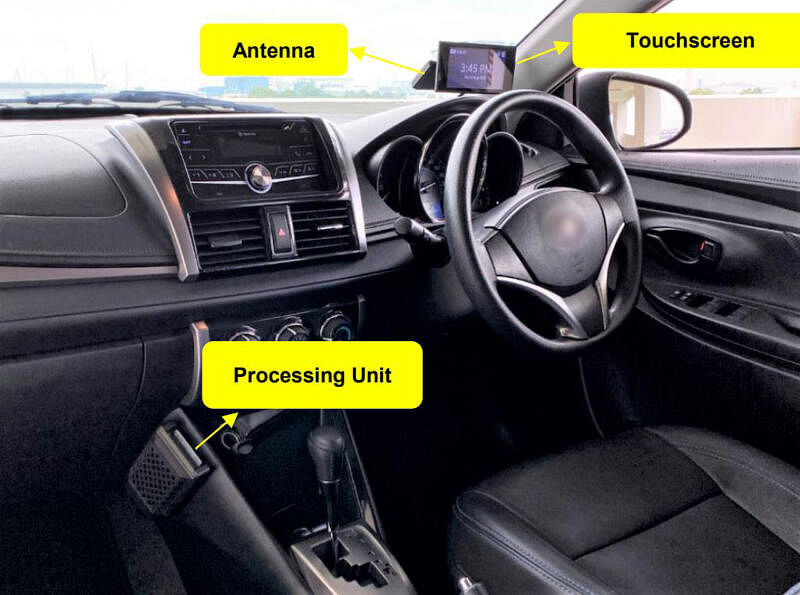Parliament: On-board unit for new ERP system to go ahead; data may be shown on smartphones in future
Sign up now: Get ST's newsletters delivered to your inbox

The LTA will offer vehicle owners a few options to gather feedback on, for instance, what is to be shown on the OBU touchscreen display.
PHOTO: LTA
Follow topic:
SINGAPORE - The public feedback is that the on-board unit (OBU) to be installed in vehicles next year is too bulky, but Senior Minister of State for Transport Amy Khor said on Monday (Oct 5) the authorities will go ahead with the device, even as they continue to explore how to make it better.
One reason is that the Land Transport Authority (LTA) is contractually bound to the OBU design after awarding the tender in 2016, so it cannot make alterations without incurring extra costs.
The LTA, however, will offer vehicle owners a few options to gather feedback on, for instance, what is to be shown on the OBU touchscreen display.
"For example, the display can be kept black most of the time, and only display ERP charges paid when a transaction is effected," she said in Parliament.
"As a possible future upgrade, LTA is also studying whether information from the OBU can be pushed to our smartphones, which can then be used as the display screen instead."
Dr Khor was responding to some MPs, including Mr Melvin Yong (Radin Mas) and Mr Saktiandi Supaat (Bishan-Toa Payoh GRC), who had indicated the larger screen of the new OBU could be a distraction to drivers and had asked whether the OBU could be replaced by smartphones.
Previously, Transport Minister Ong Ye Kung had said the LTA could, through the screens, alert motorists about important traffic-related information.
The LTA also said the screens could show locations of nearby school zones, but sceptical motorists pointed out that that would simply replicate the functions of the existing navigation panels of many new vehicles.
The new OBU for cars, to be installed from the second half of next year, comprises an antenna, a touchscreen display to be mounted near the windscreen and a processing unit to be installed under the dashboard.
It will be compatible with the new Electronic Road Pricing (ERP) system that will be switched on in the middle of 2023, to replace the existing ERP infrastructure, which has been in operation for 22 years.
Dr Khor said the current ERP system is getting increasingly difficult and expensive to maintain and so "there is an urgency, a need to implement the next-gen ERP" without introducing further changes that could upset the timeline.
"So what we want is to ensure a smooth installation of the next-gen ERP and to do this, the display unit will (first) be a standard issue.
"We also need time to work with the contractors and the consultants to come up with the programme to be able to push OBU specific data to the mobile app."
In what was described as a "show-and-tell" by an MP, Dr Khor held up a model of today's in-vehicle unit (IU) and the new OBU to show that the new unit is only marginally bigger.
The OBU display unit is 15cm x 8cm x 2cm, while the IU is 12cm x 8cm x 3cm.
There remain concerns, however, that the way the units are mounted on the windscreen could affect drivers' visibility.
Dr Khor said LTA is consulting workshops and motor vehicle agents to make sure blockage of the windscreen is "very minimal", and that the OBU unit can be folded away.
Apart from time constraints, she cited reasons of data security for choosing the OBU over mobile phones.

She said the ERP system will have the data of more than one million motorists and that the OBUs have more security features than mobile phones.
For mobile phones to work consistently as a substitute, motorists will also have to remember to carry their smartphone, ensure it is sufficiently charged and connected to a cellular network, and that the ERP payment app is launched throughout the journey.
"There are bound to be numerous unintended failed transactions and inconveniences caused," she added.
Opposition MP He Ting Ru (Sengkang GRC) asked what the tender's specifications were that led to "us being bound by the design that we committed to four years ago, rather than allowing for flexibility to update that as and when we went along".
She asked if future calls for tender should allow for greater scope for public consultation and design tweaks, especially as technology moves very quickly these days.
Dr Khor said she did not have details of the contract but that all contracts require certain specifications to be put up for contractors or tenderers to have "some amount of certainty".
"Within those limits... there is room for consultation," she said.
She noted that the contractors of the OBU have themselves done internal consultations. The ministry has also engaged Nanyang Technological University to do a study on the display features, as well as convened two independent reviews on the unit's security features.
"It is a first-of-kind project. It's an international tender, and there is no reference point. So, we did take a bit of time," she said.
The first OBU will be given free for existing Singapore-registered vehicles and more details on their installation will be given later.
Further information on the price and warranty of the device will be announced by the LTA nearer the OBU's release date.

